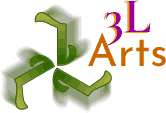Ripples and Reflections
Updated: Oct 29, 2024
"Steal Like An Artist" is a book by Austin Kleon and the first of ten things he wishes someone would have told him when he started out as an artist. By "stealing" he doesn't mean directly copying. But, in his words, "What a good artist understands is that nothing comes from nowhere. All creative work builds on what came before. Nothing is completely original."
Although I hadn't read Kleon's book at the time, I feel my piece, "Avocet Reflecting" is an example of this philosophy.

Inspired by Andrew Denman's acrylic painting, "Pick Up Sticks," and Phillip Weigard's polymer clay sunset tutorial, I set out to make a piece I had imagined for some time. I loved the combination of realism and abstraction in some of Andrew's work and I recognized that his process was similar to the mokume gane technique used for polymer clay (and metal).
Polymer clay mokume gane usually creates somewhat random patterns unless a stamp is used to create the impressions. But Phillip's tutorial pointed the way for me to create a more intentional result.
I started by making two gradient "Skinner blends" of clay. One from darker and lighter blues for the base layer of the water (below, left) and the other from shades of green and tan (below, right) that will represent the reflections of plants on the shoreline.

Following Phillip's technique, I rolled up the green and tan blend into a round plug with green on one end and tan on the other (below, left). Then flattened it into a rectangular block with green on the top and tan on the bottom (below, right).

I then flattened the block to a thin sheet in the pasta machine. Here you see that thin sheet with the green on top, ready to be placed on the blue gradient base and trimmed.

I made another, slightly different, blue blend. It was longer and narrower than the base layer (below, left). This I cut in half, placing the darker edges together in the middle (below, right). This layer went on top of the green and tan layer.

I used several different tools including this needle tool to "draw" the design of the water, pressing deeply into the three layers of clay.

Then I used a thin, very sharp blade to shave off clay. Where the tools had pressed down into the clay, colors from the upper layers remained. In areas not touched by the tools, clay was removed down to the base layer and you can see the dark to light gradient from the top to the bottom of the base layer.

I put another layer of scrap clay underneath (below, left) and trimmed it. And, finally, I ran the whole thing from side to side through the pasta machine to widen the ripple design and make the "water" completely flat (below, right).

This was actually a test in preparation for a larger piece to see how much the last step would stretch the design. So I set this piece aside for quite a while until a local art show came up with the theme of "Reflection."

I decided to add one of my favorite birds, an American Avocet. I sculpted it on a small piece of teflon and baked it. Then I drew its outline on a piece of tracing paper. Turning the paper upside down, I could transfer the location of the bird's reflection onto the still unbaked water by poking tiny holes through the paper with a tattoo needle.

I used a variety of tools again to impress and carve out raw clay where I wanted to add the reflection.

I baked the water and after that added raw clay in the bird's colors into the low areas, smoothing it off so it is perfectly level with the rest of the water.

I placed the bas-relief bird on the background, joined by a layer of liquid polymer clay, and the whole piece was baked on final time to set the bird's reflection and permanently attach the bird.


